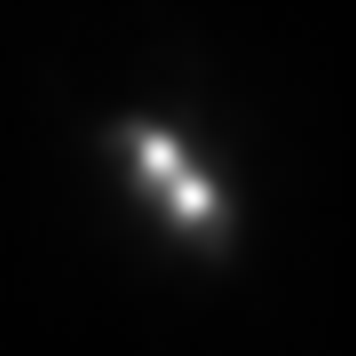BREAKING NEWS: 10th Planet Discovered, Bigger than Pluto

Artist rendering of the 10th planet, announced July 29, 2005 by Mike Brown of Caltech. It is larger than Pluto. The Sun is in the background
Developing. This story will be updated shortly. Last Update: 8:54 p.m. ET
Astronomers have discovered a new planet in our solar system, a world larger than Pluto.
It is the first time an object so big has been found in our solar system since the discovery of Pluto 75 years ago.
The discovery, announced today by Mike Brown of Caltech, came just hours after another newfound object, one slightly smaller than Pluto, was announced.
The new planet, temporarily named 2003 UB313, is about three times as far from the Sun as is Pluto.
"It's definitely bigger than Pluto," said Brown, who is professor of planetary astronomy. The object could be up to twice as large as Pluto, Brown told reporters in a hastily called teleconference Friday evening.
The object is highly inclined to the main plane of the solar system, where most of the other planets orbit. Some astronomers may view it as a Kuiper Belt Object and not a planet. Pluto itself is called a Kuiper Belt Object by many astronomers.
"Pluto has been a planet for so long that the world is comfortable with that," Brown said in the teleconference. "It seems to me a logical extension that anything bigger than Pluto and farther out is a planet."
The assertion is one that several astronomers have dreamed of making in recent years as a bevy of objects roughly half the size of Pluto have been found.
Next up: Mars-sized objects?
Alan Stern of the Southwest Research Institute and leader of NASA's New Horizons mission to Pluto, predicted in the early 1990s that there would be 1,000 Plutos out there. He has also contended that there would be Mars-sized objects in our solar system and even possibly other worlds as large as Earth.
In a telephone interview after Friday's announcement Stern, who was not involved in the discovery, said he stands by those predictions and expects Mars-sized objects to be found within decades.
"I find this to be very satisfying," Stern said of the 10th planet. "It's something we've been looking for for a long time."
Stern stopped short of calling it one of the greatest discoveries in astronomy, however, because he sees it as just one more of many findings of objects in this size range. Last year, for example, Brown's team found Sedna, which is about three-fourths as large as Pluto.
Stern sees the outer solar system as an attic full of undiscovered objects. "Now we have the technology to see them," he said. "We're just barely scratching the surface."
Way out there
The new world is about 97 astronomical units from the Sun. An astronomical unit is the distance between the Sun and Earth. The new planet becomes the farthest-known object in the solar system, and the third brightest of the Kuiper belt objects.
It was found using the Samuel Oschin Telescope at Palomar Observatory.
Backyard astronomers with large telescopes may be able to spot the planet No. 10.
"It will be visible over the next six months and is currently almost directly overhead in the early-morning eastern sky, in the constellation Cetus," says Brown, who made the discovery with colleagues Chad Trujillo, of the Gemini Observatory, and David Rabinowitz, of Yale University, on Jan. 8.
The team had hoped to analyze the data further before announcing the planet but were forced to do so Friday evening because word had leaked out, Brown said.
Brown and Trujillo first photographed the new planet with the 48-inch Samuel Oschin Telescope on Oct. 31, 2003. However, the object was so far away that its motion was not detected until they reanalyzed the data in January of this year. In the last seven months, the scientists have been studying the planet to better estimate its size and its motions.
Estimating size
Scientists infer the size of a solar-system object by its brightness and distance. The reflectiveness of the new planet is not known, however, which is why the estimate of it's diameter ranges from one to two times the size of Pluto. But those constraints are well supported by the data, Brown said.
"Even if it reflected 100 percent of the light reaching it, it would still be as big as Pluto," says Brown. "I'd say it's probably one and a half times the size of Pluto, but we're not sure yet of the final size. But we are 100 percent confident that this is the first object bigger than Pluto ever found in the outer solar system."
The upper size limit is constrained by results from the Spitzer Space Telescope, which records heat in the form of infrared light. Because the Spitzer can't detect the new planet, the overall diameter must be less twice Pluto's size, Brown said.
Brown and his colleagues have proposed a name for the new planet to the International Astronomical Union, and they are awaiting the decision of this body before announcing the name.
fonte: http://ww.space.com/scienceastronomy/05 ... lanet.html
Putz !!! Impressionante
[ ]´s


